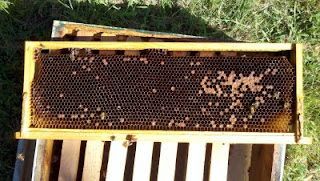
1) The queen will be near the youngest bees.
2) The queen will either be:
Moving in a straight line, plowing through other bees
Moving in a straight line, plowing through other bees
or
Staying in one place with a circle of attendants around her
3) The queen has a longer and pointier abdomen than the other bees
These three tricks might not seem like much but I've found they are the key to locating the queen in a hive when applied in this order. Most new beekeepers are only told #3, what the queen looks like. I've found that this information is not sufficient and in fact on its own makes the task of finding the queen more difficult than having no information at all! If you have two bees side by side and want to know which one is the queen then yes, look for the longer abdomen and the hairless thorax etc.
Applying #1:

If you have a hive of bees you need to find the frame a queen is on. This is where #1 comes in, in the hive you have a few frames with fresh eggs on it (a bee is an egg for 3 days) and this is where the queen will be located since she is the one who lays these eggs. It should be obvious where the brood is so start there and move through the box one frame at a time. You will see the brood getting younger and younger, from capped to uncapped and from larger larva to smaller. You will come to the eggs fairly quickly, the eggs who are near the small larvae are the 3 day old eggs. I find this part very interesting, this means that this is where the queen was three days ago! You're on her trail, tracking her down now.
Continuing in that same direction you will see more eggs, younger and younger. If you reach the end of the brood nest the queen probably went up or down a box so continue your search there. Before long you will come to a frame that has eggs and empty cells and possibly emerging brood. This is the frame you are most likely to find the queen on, good work!
Applying #2:
Now that you have a frame (or a couple of frames) that is likely to have the queen you can apply the next trick. There are probably about 1,000 bees on the single side of the frame you are looking at and there might be one queen among them. If she has been marked with paint or is an Italian queen with a bright gold abdomen you can probably spot her right away but if you like to keep unmarked Carniolan queens like I do you'll need to take a closer look. It is tempting to start looking at individual bees to find the one that looks like a queen but I've found it is easier to instead look for her behavior. I most frequently find the queen moving.
Bees rarely sit still when there's work to do but they don't usually run all over either. The bees are probably milling about in small circles, almost like they are trying to look busy without actually going anywhere. The queen on the other hand covers significant distance when she is moving. She also tends to plow through other bees instead of finding a careful way around congested areas. I've never seen a worker or drone doing this so if you spot this behavior you've found your queen.
If the queen isn't moving like this she's still easy to find if you know what to look for. Whether she is laying, eating, being cleaned, or just collecting her thoughts if the queen isn't moving quickly she will be the center bullseye of this circle as you can see in the image at the top of this page. The bees in this circle are often called the queen's attendants although I've not seen these attendants actually follow the queen much. They seem to come and go rather than follow the queen and attend to her individually.

Applying #3:
Now that you've found the queen (or rather a bee you think is the queen) you can apply #3. The characteristics of a queen are great for determining if an individual is a queen and they are quite simple when used in the comparison of two bees. Which one has an abdomen so long it isn't covered by her wings? That's the queen, although some workers have longer abdomens but not nearly as long as a queen's. Which one has a hairless thorax (the area where the wings meet the body)? That's the queen, although old workers also have hairless thoraxes.
Now that you've found the queen you can get on with whatever work you were doing that required finding the queen. If you had to find the queen it is probably important that you know where she is from here on out for your task. I've made the mistake a few times of finding the queen and then losing here again at which point I usually give up and close the hive. Finding a queen after she is already disturbed is much harder and you can't apply the 3 tricks above as reliably. Because of that you may want to put the queen in a little queen cage like the one pictured here. I usually do something simpler and just set the frame with the queen someplace safe and out of the way while I'm doing the real work that required finding the queen.





























